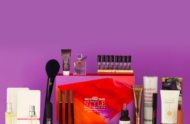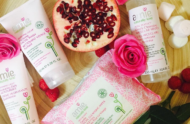In an attempt to live a little cleaner, and therefore greener, lately I’ve (Jem, Blog Editor – hello!) become more aware of the concept of ‘clean beauty’. The terms ‘natural’ and ‘organic’ are circulated a lot in the beauty world, but it’s challenging to understand what clean beauty really means, especially when – unlike the food and textiles industries – there are no legal standards for beauty brands to determine what can and cannot be labeled as natural or organic.
Despite certifications such as the Soil Association, Cosmos and Ecocert, which each verify certain brands and products as organic, it’s still a struggle to identify the authenticity of these claims. Can a product be both natural and organic? Yes. Can brands distract from the truth when it comes to the transparency of ingredients and their quantities? Yes. It’s an endless stream of blurred lines when all we want to know is whether what we’re using is both safe and effective. Additionally, if you’re wondering what determines clean beauty, I have briefly outlined what the terms natural and organic really mean and have shared the best apps available for going green.
If a product is branded as natural, its formula is synthetic free. However, this is where it can get a little tricky when buying products that haven’t been certified. This is due to products be labeled as natural when they only have one or two natural ingredients listed in the formula. Getting a certification for products is optional for a brand, so when purchasing, you have to dig a little deeper into the ingredients and make up your own as to whether a product aligns with your preferences.
The term organic has more to do with the farming method; ingredients are farmed organically and grown without synthetic fertilisers or pesticides. There are many benefits to going organic, including being good for the environment. Organic farming avoids the use of polluting chemicals that can hinder wildlife, farmers’ health and how clean the air is. Opting for certified, organic beauty products can be compared to choosing a healthy, freshly prepared meal as opposed to over-processed foods. When making the swap, it’s worth avoiding ingredients such as PEGs, mineral oil, paraffin, SLS (sodium laureth sulfate), silicones (dimethicone, cyclopentasiloxne) and parabens.
CLEAN BEAUTY APPS
Thankfully, there are a number of apps (because let’s face it, when are we not turning to our phones for help?) that can help us make better decisions. Many are US-based, but still beneficial when looking into the ‘greenness’ of many products.
THINK DIRTY
 If you want to understand the effects of a product you’re using, turn to Think Dirty. This app provides unbiased product reviews and rates the toxicity and safety of each product you have using their database of over 300,000 beauty products. The results provide a colour coded score; white = neutral /0-2, yellow = half n’ half / 3-6 and red = dirty / 7-10. The higher the score, the worse the ingredients. The clever thing? Scanned products can be added to your Bathroom Shelf or your ‘favourites’. If the product isn’t in the database it will record it and add it at a later time.
If you want to understand the effects of a product you’re using, turn to Think Dirty. This app provides unbiased product reviews and rates the toxicity and safety of each product you have using their database of over 300,000 beauty products. The results provide a colour coded score; white = neutral /0-2, yellow = half n’ half / 3-6 and red = dirty / 7-10. The higher the score, the worse the ingredients. The clever thing? Scanned products can be added to your Bathroom Shelf or your ‘favourites’. If the product isn’t in the database it will record it and add it at a later time.
GOODGUIDE
 This app provides information on over 75,000 consumer products (spanning beauty, personal care, home, food) using a 10-point scale. Based on their social, biological and ecological effects, the higher the rating, the better the product when health and toxicity are concerned. You can browse a product catalog or search using a name or barcode. You can also access information that tells you why a product has been rated the way it has, showing you which ingredients are responsible and why. There are also filters available to narrow down whether a product is vegan and cruelty free. Generally, this has shown me my skincare is much cleaner than my makeup routine (old habits die hard).
This app provides information on over 75,000 consumer products (spanning beauty, personal care, home, food) using a 10-point scale. Based on their social, biological and ecological effects, the higher the rating, the better the product when health and toxicity are concerned. You can browse a product catalog or search using a name or barcode. You can also access information that tells you why a product has been rated the way it has, showing you which ingredients are responsible and why. There are also filters available to narrow down whether a product is vegan and cruelty free. Generally, this has shown me my skincare is much cleaner than my makeup routine (old habits die hard).
EWG’S SKIN DEEP
 This app is good for checking out ingredients and toxicity scores using a scanning system that scans product barcodes. Results are shown using a traffic light colour rating; red for hazard (high), amber (moderate), green (low or none). The results are also broken down into categories for cancer, developmental and allergy. This app gives you the option to search a product by name, just in case you don’t have a barcode readily available.
This app is good for checking out ingredients and toxicity scores using a scanning system that scans product barcodes. Results are shown using a traffic light colour rating; red for hazard (high), amber (moderate), green (low or none). The results are also broken down into categories for cancer, developmental and allergy. This app gives you the option to search a product by name, just in case you don’t have a barcode readily available.
How clean is your beauty routine? Tweet us and let us know! Alternatively, shop some of our favourite natural and/or organic products in our build your own selection.



